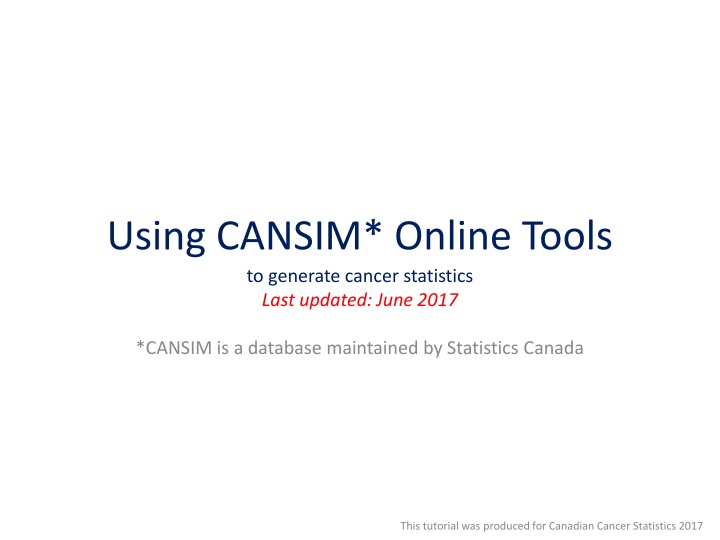
Generating Cancer Statistics Using CANSIM Online Tools
Access and utilize CANSIM online tools to generate comprehensive cancer statistics in Canada, including new cases, mortality rates, and population estimates by age, sex, and cancer type.
Download Presentation

Please find below an Image/Link to download the presentation.
The content on the website is provided AS IS for your information and personal use only. It may not be sold, licensed, or shared on other websites without obtaining consent from the author. If you encounter any issues during the download, it is possible that the publisher has removed the file from their server.
You are allowed to download the files provided on this website for personal or commercial use, subject to the condition that they are used lawfully. All files are the property of their respective owners.
The content on the website is provided AS IS for your information and personal use only. It may not be sold, licensed, or shared on other websites without obtaining consent from the author.
E N D
Presentation Transcript
Using CANSIM* Online Tools to generate cancer statistics Last updated: June 2017 *CANSIM is a database maintained by Statistics Canada This tutorial was produced for Canadian Cancer Statistics 2017
Online Data Tools: SelectedCANSIM tables cancer incidence Table number Description New cases of primary cancer, by cancer type, age group and sex, Canada, provinces and territories Provides counts of new cancer cases and crude incidence rates (and 95% confidence intervals) for Canada or provinces and territories by age, sex, year and cancer type. 103-0550 New cases of primary cancer, by cancer type, age group and sex, Canada excluding Quebec, provinces (excluding Quebec) and territories Similar to CANSIM Table 103-0550 but does not include Quebec and may include additional year(s) of data 103-0555 New cases and 2011 age-standardized rates for primary cancer, by cancer type and sex, Canada, provinces and territories: Provides counts of new cancer cases and age-standardized incidence rates (and 95% confidence intervals) for Canada or provinces and territories by sex, year and cancer type. 103-0554 New cases and 2011 age-standardized rate for primary cancer by cancer type and sex, Canada (excluding Quebec), provinces (excluding Quebec) and territories Similar to CANSIM Table 103-0554 but does not include Quebec and may include additional year(s) of data 103-0556 Cancer incidence, by selected sites of cancer and sex, three-year average, Canada, provinces, territories and health regions (2015 boundaries) 103-0406 Cancer incidence, by selected sites of cancer and sex, three-year average, census metropolitan areas 103-0407 This tutorial was produced for Canadian Cancer Statistics 2017
Online Data Tools: Selected CANSIM tables Cancer mortality and population estimates Table number Description Deaths, by cause, Chapter II: Neoplasms (C00 to D48), age group and sex, Canada Can provide annual number of cancer deaths for Canada by age, sex and cancer site 102-0522 Deaths and mortality rate, by selected grouped causes, age group and sex, Canada Can provide annual deaths and crude mortality rates for Canada by age, sex, cause of death 102-0551 Deaths and mortality rate (age standardization using 2011 population), by selected grouped causes and sex, Canada, provinces and territories Can provide the annual number of deaths and the and crude and age-standardized mortality rates for Canada or provinces and territories by sex, year and cause of death 102-0553 Estimates of population, by age group and sex for July 1, Canada, provinces and territories Population by province, age, year and sex 051-0001 This tutorial was produced for Canadian Cancer Statistics 2017
Finding CANSIM tables: Option 1: Search by specific table number or keyword From the CANSIM search bar on the main CANSIM webpage, enter the table number into the search bar: For example, to locate table 103-0550 for cancer incidence data, we can enter this table number as the search string This tutorial was produced for Canadian Cancer Statistics 2017
Finding CANSIM tables: Option 2: Browse tables by survey or database Directly below the CANSIM search tool are options for browsing available tables by either Subject or Survey . Clicking on the Survey tab yields a table containing a large number of Statistics Canada surveys and databases. From this list, users can select Canadian Cancer Registry (record number 3207) and Vital Statistics Death Database (record number 3233) for information on tables related to new cases of cancer and cancer deaths respectively. This tutorial was produced for Canadian Cancer Statistics 2017
Generating Custom Cancer Statistics Summaries in CANSIM As an example of how CANSIM can be used to generate cancer statistics of interest, we have shown how a user could generate the following custom table of cancer statistics: Annual counts of new cancers for colorectal, prostate, and lung cancers for British Columbian men between 2008 and 2012. The following steps can be taken to generate this summary This tutorial was produced for Canadian Cancer Statistics 2017
Generating Custom Cancer Statistics Summaries in CANSIM Step 1: Enter table number 103-0550 into the search bar and hit search. This will land on the default data table below. This tutorial was produced for Canadian Cancer Statistics 2017
Generating Custom Cancer Statistics Summaries in CANSIM Step 2: To customize this summary, click on the Add/Remove data tab where additional selections can be made. This tutorial was produced for Canadian Cancer Statistics 2017
Generating Custom Cancer Statistics Summaries in CANSIM Step 3: From Geography , select the region of interest (here, British Columbia). This tutorial was produced for Canadian Cancer Statistics 2017
Generating Custom Cancer Statistics Summaries in CANSIM Step 4: From Sex , select the sex of interest (here, males). This tutorial was produced for Canadian Cancer Statistics 2017
Generating Custom Cancer Statistics Summaries in CANSIM Step 5: From the Primary types of cancer menu, select the cancers of interest (here, lung, colorectal and prostate). This tutorial was produced for Canadian Cancer Statistics 2017
Generating Custom Cancer Statistics Summaries in CANSIM Step 6: From Time Frame , select the range of years of interest (here, 2008 to 2012). Step 7: When all selections have been made, click apply to generate the custom table. You will be automatically directed to the Data Table , where your custom summary table will be displayed. This tutorial was produced for Canadian Cancer Statistics 2017
Generating Custom Cancer Statistics Summaries in CANSIM The following table should now appear within the Data Table tab. Users of CANSIM should take note of the various footnotes that appear below the table. These explain important metadata concerning the information in this CANSIM table. Footnotes will appear below the table This tutorial was produced for Canadian Cancer Statistics 2017
Generating Custom Cancer Statistics Summaries in CANSIM Step 8:The custom data table can be downloaded using the Download tab. This will provide the user the ability to download the data into a CSV file format. Note the two options: Option 1 will download your custom table, whereas option 2 will download the entire underlying data from the CANSIM table. This tutorial was produced for Canadian Cancer Statistics 2017
Generating Custom Cancer Statistics Summaries in CANSIM Step 9: Clicking Download the file from CANSIM should download the CSV file (in, for example, Excel). This tutorial was produced for Canadian Cancer Statistics 2017
Differences between data for CANSIM and Canadian Cancer Statistics CAUTION: Users of CANSIM tables should be aware that there are some differences between data compiled for the Canadian Cancer Statistics publication and those used in the CANSIM online tables. For details on CANSIM data, CANSIM users should review the footnotes provided under each CANSIM table. The information found in those footnotes can be compared to the details provided in Appendix II of Canadian Cancer Statistics. The following describes some notable differences between the methodology used in compiling the statistics in the CANSIM online tables and Canadian Cancer Statistics. It is not an exhaustive list. 1. The number of age groups used to age standardize the rates was 19 in CANSIM and 18 in Canadian Cancer Statistics. The difference is that the 85 89 and 90+ age groups used in CANSIM were collapsed into 85+ age group for Canadian Cancer Statistics. 2. In the data used for Canadian Cancer Statistics, cases identified through death certificate only (DCO) were imputed for the provinces of Ontario (2008 onward) and Quebec (2010). This approach was not done for the CANSIM data. This could lead to differences in statistics for these provinces and for Canada as a whole. This tutorial was produced for Canadian Cancer Statistics 2017
Differences between data for CANSIM and Canadian Cancer Statistics (continued) 3. Cancer groupings sometimes differ between CANSIM tables and Canadian Cancer Statistics. For example, the leukemia group from Canadian Cancer Statistics is split into several leukemia subtypes in some CANSIM tables (e.g. acute lymphocytic leukemia, chronic lymphocytic leukemia, etc.). Users should carefully compare cancer group definitions across data sources. 4. Data on new cancer cases for the province of Quebec are not available in the Canadian Cancer Registry for diagnosis years beyond 2010. CANSIM tables 103-0555 and 103-0556 exclude data from Quebec while CANSIM tables 103-0550 and 103-0554 carry forward the Quebec incidence data from 2010 to the diagnosis years 2011-2013. A different approach to imputing the Quebec data was used for Canadian Cancer Statistics. This tutorial was produced for Canadian Cancer Statistics 2017



















